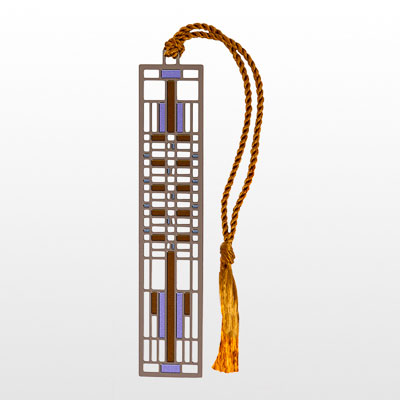Tel : (+33) 4 94 63 18 08
9am - 6pm from Monday to Sunday
All products Frank Lloyd Wright • Products of the topic Architecture
Frank Lloyd Wright Bookmark : Coonley Playhouse Window
REF : WRIGHT-MP-01
In stock
Only 1 in stock
Unavailable
15,00 €
Frank Lloyd Wright Bookmark : Coonley Playhouse Window
Solid brass, electro-plated with gold finish, giclee print
Dimensions : 3 x 9.2 cm
*******************************************************************
Add an elegant touch to your readings with this bookmark inspired by the iconic works of Frank Lloyd Wright, one of the masters of architecture. This artistic homage to his creative genius is a must-have for design and architectural art enthusiasts.
Organic architecture
The movement of organic architecture, led by visionary Frank Lloyd Wright, emerges as a celebration of harmony between humanity, nature, and the built environment. Inspired by the forms and cycles of nature, this architectural approach pushes traditional boundaries to create structures in symbiosis with their surroundings. Frank Lloyd Wright, a pioneer of organic architecture, revolutionized architectural design by emphasizing the fluidity and fusion of lines, materials, and functions. His iconic creations such as Fallingwater perfectly illustrate his unique approach, where horizontal lines blend with the surrounding waterfalls, forming a harmonious dialogue between the artificial and the natural. Organic architecture transcends mere aesthetics to become a true philosophy. It reminds us that constructed spaces should not only shelter people but also elevate them spiritually and emotionally. Wright's organic spaces reflect this profound conviction by integrating elements like natural light, natural patterns, and smooth circulation to create environments that promote well-being. By embracing flexibility and adaptability, organic architecture distinguishes itself through its ability to adjust to the changing needs of modern life while respecting the surrounding nature. Through the visionary work of Frank Lloyd Wright and other architects influenced by this movement, organic architecture continues to inspire a holistic approach to design, reminding us that beauty and functionality can organically intertwine to create spaces that elevate the spirit and nurture the soul.
Discover the artist
Lloyd Wright Frank
In the annals of architectural history, the name of Frank Lloyd Wright resonates like a timeless echo, carrying the imprints of daring creativity and a vision that transcends eras. Born on June 8, 1867, in Richland Center, Wisconsin, Wright was destined to become a titan of architecture, pushing the boundaries of traditional design and leaving an indelible mark on the global built landscape. His artistic journey began under the protective shadow of Louis Sullivan, the father of modern architecture, where he laid the foundations of his unique architectural philosophy. But Wright did not merely follow in his mentor's footsteps; he surpassed them, creating his own architectural language imbued with an intrinsic harmony with nature and humanity. The organic aesthetic, a cornerstone of Wright's work, revealed itself in his audacious creations. His buildings seemed to naturally emerge from their surroundings, blending harmoniously with the landscape and transforming artifice into an extension of nature itself. From the majestic Fallingwater to the splendid Robie House, each structure attests to his mastery of space, light, and form. Yet, Wright was not merely an architect. He was a visionary thinker, an advocate for harmony between humanity and its habitat, and a fervent supporter of the human experience enriched by architecture. Wright's journey was not without controversies or challenges, but these trials fueled his determination and amplified his creativity. Through changing epochs, his influence endures, inscribing his name in the golden pages of architectural history. Frank Lloyd Wright passed away on April 9, 1959.




